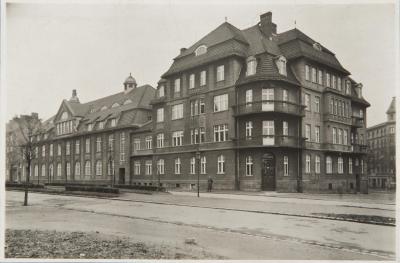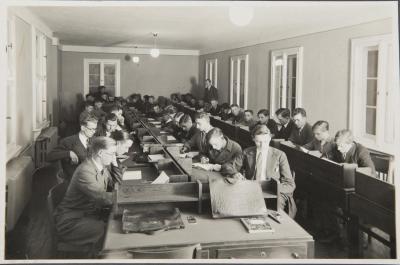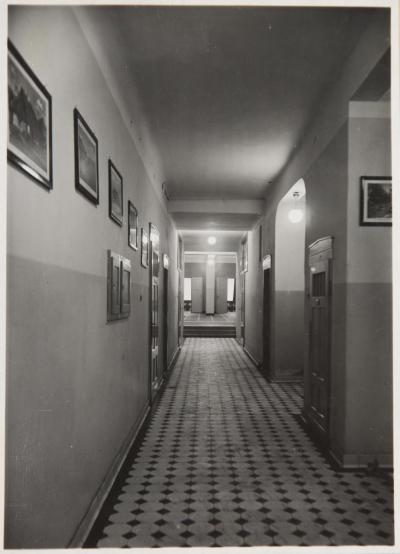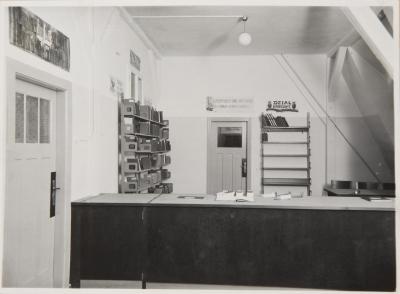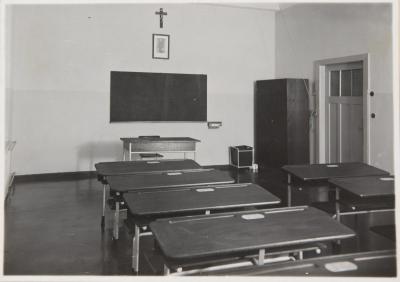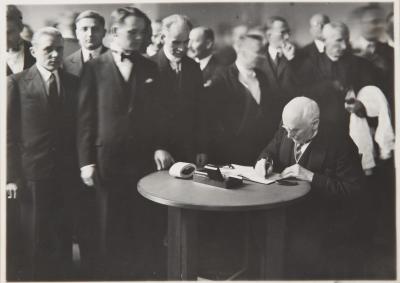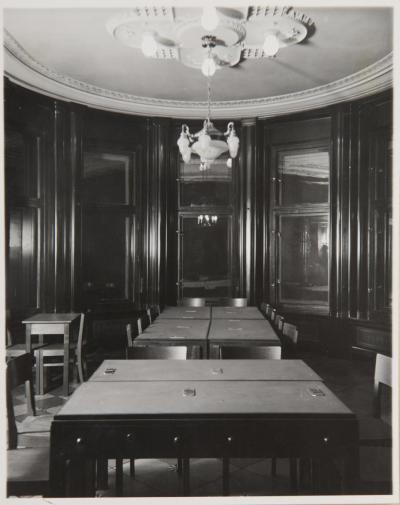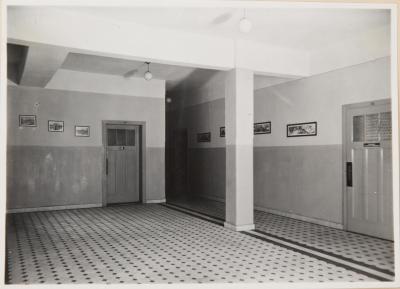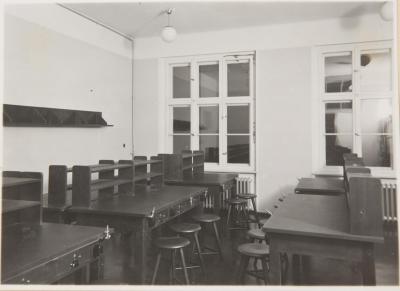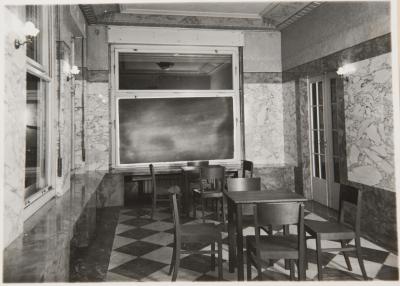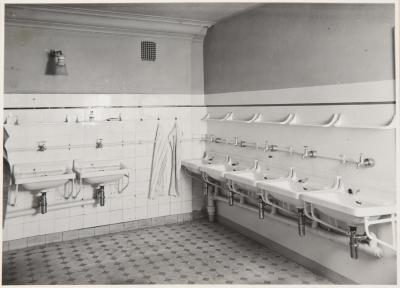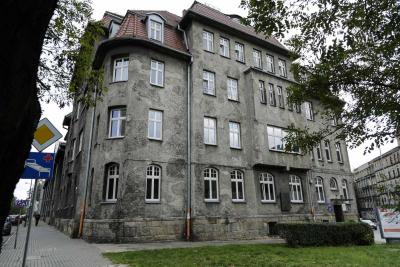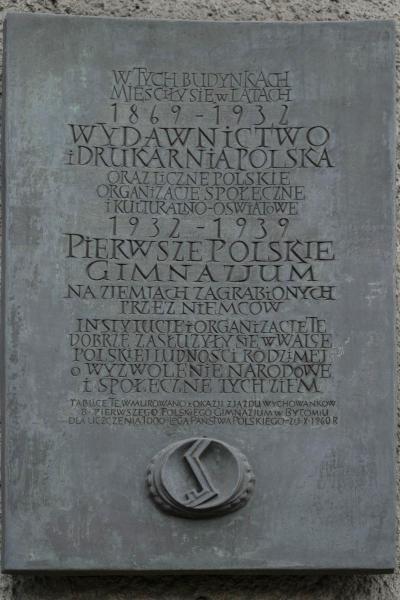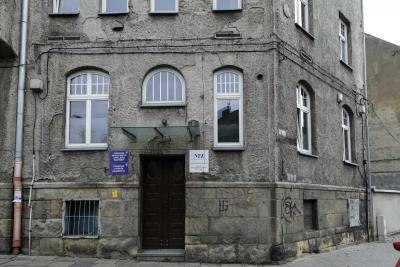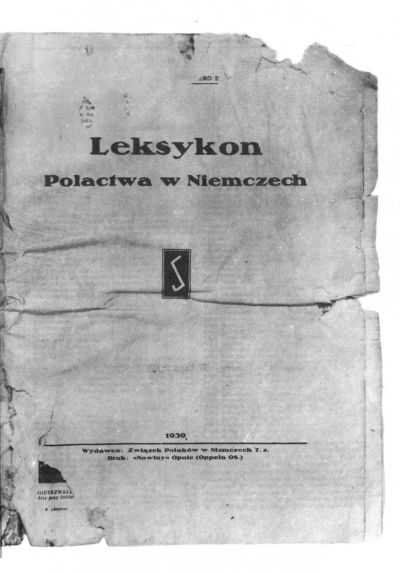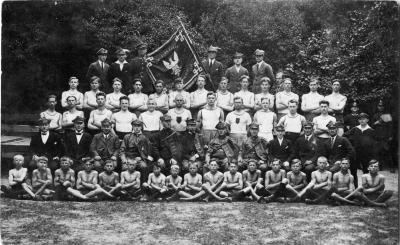The Polish grammar school in Bytom
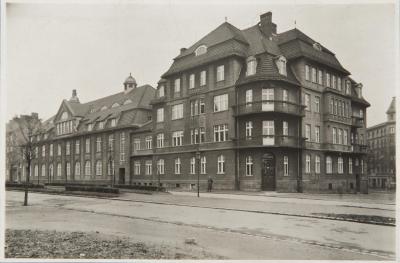
After the referendum that sealed the partition of Upper Silesia into Polish and German sections, the Union of Poles in Germany (Związek Polaków w Niemczech)[1] attempted to set up a secondary school on Polish lines in the area of the Reich, providing tuition up to A-level. As early as the 1920s the Polish-Catholic School Society in Opolan Silesia (Polsko-Katolickie Towarzystwo Szkolne dla Śląska Opolskiego), the local section of the Union, had for administrative reasons decided not to pursue its efforts to set up a Polish State Grammar School in the remaining German voting areas, although the Polish minority had been accorded such a right according to the 1922 Geneva Convention. The Committee for Celebrating the 21st Anniversary of the Struggle for a Polish School (Komitet Obchodu 25–lecia Walki o Szkołę Polską) was set up in February 1930 under the patronage of Ignacy Mościcki, the President of the Polish Republic, to mark the 25th anniversary of the first day of the school strike in the Prussian and Russian sectors. One of the primary objectives set by the committee was to begin preparations to set up a private Polish Grammar School in Germany. This would be financed by the Fund of the Union of Poles in Germany and the Polish government. In addition donations were to be collected from the Polish population. These flowed into the newly founded Fund for the Promotion of the Polish School System Abroad (Fundusz Szkolnictwa Polskiego Zagranicą) under the patronage of the then Marshal of the Senate, Władysław Raczkiewicz.[2]
The site of the Grammar School
Initially it was an open question as to where the Polish Grammar School should be sited. Both Silesia and Eastern Prussia came into consideration. There were two possible towns in Silesia: Opole and Bytom. Opole was the seat of the district government and the local headquarters of the Union of Poles, the Polish School Society (Polskie Towarzystwo Szkolne) and the Polish Boy Scouts. The fact that Bytom was near the border spoke in its favour. But in the end the decision proved accidental. “Katolik” (The Catholic), a publishing house in Bytom was declared insolvent and it was decided to put its building at the disposal of the Polish Grammar School. On 24th March 1932 the Opole section of the Polish Catholic School Society (Polsko-Katolickie Towarzystwo Szkolne) applied to the Bytom Building Office for its approval to restructure the building for school purposes. The application triggered off a wave of protest in the local press and objections were even sent to the Ministry of the Interior. The German side torpedoed the efforts of the Polish side by trying to prove that a Polish minority did not exist in Upper Silesia, especially in Bytom.[3]
Nonetheless the application was granted. The comprehensive rebuilding measures caused the initiators of the Bytom school to apply to the Provincial College in Opole for permission to have a classical public Grammar School offering its students the chance of attaining A-levels. Subsequently a special conference was held in Berlin on 9th August 1932. The Ministry of Culture was represented by Friedrich Adolf Trendelenburg, the Ministry of the Interior by privy counsellor, Gürich, and the Foreign Ministry by the Ministerial Director, Meyer. The Supreme President, Hans Lukaschek, represented the district government of Opole. The upshot was that the application by the Polish side was accepted, along with all the recommended teaching candidates except for the candidate for the post of director, Miłosz Sołtys. This latter decision was made because people considered that the head of the school should be a German citizen in order to ensure that the students would have a correct political outlook. In order to take the sting out of this problem the school counsellor, Dopke, from Bytom was appointed the trustee of the College and given the job of supervising the school. Furthermore people pointed to the name of the school which was officially called the Prywatne Gimnazjum Rozwojowe z polskim językiem nauczania (Private Grammar School under Construction with Lessons in Polish), since the German authorities thought that there was no good reason to set up a school with classes at all levels, i.e. including an A-level class. Originally the intention was to have three lower classes, from class 6 to class 4. And in order to assess the state of knowledge held by the future students in the Grammar School, Germans should carry out examinations before deciding whether or not to open the school.[4]
The three-storey building of the Polish Grammar School was in Kurfürstenstraße 21 (today’s aleja Legionów). It had classrooms for physics, chemistry, biology and drawing as well as an assembly hall, a gymnasium, a chapel and a library equipped with a film projector, a slide projector and a radio.[5]
[1] The Union of Poles in Germany was set up in Berlin in August 1922 at a meeting of representatives of Polish centres in Germany. It was officially registered on 6th November 1923. One of its main aims was to ensure the rights of the Polish minority and protect Polish economic, social and cultural interests. The Union comprised five regions, including region number I - Opolan Silesia. The regional headquarters of the Union in Bytom was set up at the assembly on the 18th November 1928. The board of management consisted of the following persons: Kazimierz Malczewski, Pfarrer Czesław Klimas, Pfarrer Karol Koziołek and Franciszek Myśliwiec (H. Müller, Die polnische Volksgruppe im Deutschen Reich, Warschau 1941, pp. 159 and 196; J. Perdelwitz, Die Polen in Deutschland, Schwerin 1932, p. 9; T. Musioł, Polacy w Niemczech w latach 1918–1939, Opole 1963, pp. 26–27).
[2] J. Lubos, Dzieje polskiego gimnazjum w Bytomiu w świetle dokumentów i wspomnień, Opole 1971, p. 15; Walka o szkołę narodową dla Polaków Zagranicą. Zeszyt Propagandowy Funduszu Szkolnictwa Polskiego Zagranicą, 1934, pp. 19–21; J. Lusek, Niemieckie i polskie szkolnictwo w Bytomiu (1740–1945), Opole 2010, p. 155. Vgl. Komitet Obchodu 25-lecia Walki o Szkołę Polską: sprawozdanie, Warszawa 1934.
[3] The German Institute for International Pedagogical Research. Library of Education History in Berlin (designated in the following as “BB“), private estate. Files from the Private School in Bytom. Polish grammar school, Sign. 140, correspondence. Syllabuses. Lists of school books (1931–1933), Polish and German newspaper articles (1932–1933); Archiwum Akt Nowych, Ministerstwo Spraw Zagranicznych [Archive of recent files, Ministry of Foreign Affairs], Sign. 7226, Instytut Śląski w Katowicach [Silesian Institute in Katowice] (Kommuniqué Nr. 15: E. Zdrojewski, Szkolnictwo polskie, op. cit.; Kommuniqué Nr. 16: E. Zdrojewski, Szkolnictwo polskie na Śląsku Opolskim. Nowe widoki rozwoju. Gimnazjum polskie, Katowice 1934); L. Ręgorowicz, Wykonanie niemiecko-polskiej Górnośląskiej Konwencji zawartej w Genewie 15 maja 1922 roku w zakresie szkolnictwa, Katowice 1961, pp. 99–100; J. Lusek, Szkolnictwo niemieckie i polskie…, p. 161–163.
[4] Archiwum Państwowe w Opolu (APO) [State Archive in Opole, designated in the following as APO], 1, Nadprezydium Prowincji Górnośląskiej w Opolu [Supreme Presidium of the province of Upper Silesia in Opole], Sign. 136, The Polish Grammar School in Bytom OS, Bl. 5–7.
[5] Państwowe w Katowicach (APK) [State Archive in Katowice, designated in the following as APK], 683, Prywatne gimnazjum z polskim językiem nauczania [Private Grammar School with lessons in Polish], Sign. 316, Album (1933), contains photos and brief description of the rooms in the school building.
The battle for the status of a state school
Since the German authorities were setting up hurdles to prevent the opening of the Polish Grammar School, the Union of Poles in Germany (the pastor, Karol Koziołek and Władysław Wesołowski) issued a formal request for assistance to the Council for the League of Nations and the Commission in Katowice. As a result the Supreme President, Hans Lukaschek, decided to open the school on 2nd November 1932. The school was given the name, Prywatna Wyższa Szkoła z gimnazjalnym programem nauki w Bytomiu (Private Secondary School with a Grammar School Programme in Bytom).[6] It was refused a classification as a Grammar School on the grounds of a directive made in 1912, which said that it was not allowed to designate educational establishments as “Grammar Schools” if they had no public legal status.[7]
On 20th January 1933 the representatives of the Polish Catholic Society in Opolan Silesia (Polsko-Katolickiego Towarzystwa dla Śląska Opolskiego) requested the Reich Ministry to grant the school a public legal status, for this would have allowed it to have its first A-level class. Despite the huge number of interventions and petitions the Ministry declined the application, which meant that the first A-level candidates had to take their examination (according to a pronouncement by the Supreme President of the Opole district government made on 13th March 1935) as external candidates before a German commission. The refusal to allow the school in Bytom to have a public legal status triggered off a huge echo in the Polish press and even in the Polish Parliament, the so-called Sejm of the Republic of Poland.[8] The arbitrator in this unhappy affair was the Chair of the Mixed Commission, [the Swiss Federal Counsellor] Felix Calonder, who worked out a compromise with representatives of the German and Polish authorities, allowing the Bytom Grammar School the right to exist as a “middle” educational establishment and prepare its students for university from 18th April 1935. Subsequently a total of 64 A-level candidates passed their exams in Bytom between 1935 and 1939.[9]
In the years in which the Grammar School pursued its work it used a Polish title: 1932 to 1933 - Prywatne Gimnazjum Polskie (Private Polish Grammar School), 1934 to 1939 - Wyższa Szkoła Prywatna z Polskim Językiem Wykładowym (Private Secondary School with Classes in Polish), 1935 to 1936 - Prywatne Gimnazjum z Polskim Językiem Nauczania (Private Grammar School with Classes in Polish), 1936 - Prywatne Polskie Gimnazjum w Bytomiu (Private Polish Grammar School in Bytom), 1936 to 1937 - Prywatna Wyższa Szkoła dla Chłopców z Polskim Językiem Nauczania. Bytom (The Bytom Private Secondary School for Boys with Lessons in Polish); and in 1937 and 1938 in German: the Bytom OS Private Secondary School for Boys with Lessons in Polish.[10]
[6] BB, private estate, Sign. 140, correspondence (1931–1932). Polish and German newspaper articles (1932–1933): „Polska Zachodnia” No. 311, dated 8.09.1932; J. Lubos, Dzieje polskiego gimnazjum…, p. 35.
[7] The name was the reason behind the request. The idea was to justify its definition as a grammar school by listing concrete examples of similar schools for minorities in Berlin and Pomerania. Furthermore it referred to the basic principle of mutuality in the sense of the Geneva Convention and named, amongst others, the grammar school for the German minority in Królewska Huta [Königshütte]. BB, private estate, Sign. 140, correspondence (1931–1932), Letter from the Towarzystwa Szkolnego [School Society] to the Department of Churches and Schools, dated 19.10.1932; J. Lubos, Dzieje polskiego gimnazjum…, Footnote 43.
[8] BB, private estate, Sign. 141, correspondence. Schoolbook register (1934–1936). Polish newspaper article in “Polska Zachodnia” dated 27.03.1935, 28.03.1935 and 08.04.1935, also in “Gazeta Polska” dated 29.03.1935; idem, a German newspaper article in “Polak w Niemczech” 1935, Nr. 5, also in “Kulturwehr” 1935, pp. 542–555. Comprehensive quotations from German and Polish propaganda, and from the speech in the Sejm on protecting the grammar school also appear in J. Lubos, op. cit., pp. 138–140.
[9] APO, 1, Sign. 765, Gimnazjum polskie w Bytomiu [Polnisches Gymnasium in Beuthen], pp. 93–99 and 256–262; BB, private estate, Sign. 143 correspondence. Examination results (1938); APK, 683, Sign. 71, correspondence with the German Ministry of Education concerning A-level examinations (1937); Sign. 73, A-level examinations (1938); Sign. 196, examinations and additional examinations for students (1937); articles in „Nowiny Codzienne” on 25.02.1937 and 21.03.1937; J. Lubos, Dzieje polskiego gimnazjum w Bytomiu…,pp. 142–155.
[10] APK, 683, Prywatne gimnazjum z polskim językiem wykładowym w Bytomiu [Private Grammar School with lessons in Polish in Bytom) (1932–1939), B. Sikora, an introduction to the stocks, p. 1.
The school opening
The official opening of the Polish Grammar School took place on 8th November 1932. It began with a mass in the Church of the Holy Trinity attended by school students, their parents and teachers along with the headmaster, Wiktor Nechayem de Felseis and a large number of representatives from Polish districts. The festivities were also attended by the Chair of the Union of Poles in Germany, Pastor Bolesław Domański, the managing director of the Union, Jan Kaczmarek, the managing director of the Opole Section of the Union, Pastor Karol Koziołek, the Chair of the Union of Polish School Societies in Germany, Jan Baczewski, the Visitator of Polish Private Schools in Germany, privy counsellor Brasse, the Chair of the Union of Polish Co-operatives in Germany, Stefan Szczepaniak, and the Director of the Polish Catholic School Society in Opole, Jan Szreiber. The Polish government was represented by the Consul General in Opole, Leo Malhomme and the Polish Consul from Breslau, [Stefan Janusz] Bratkowski. Also present were the chair of the Mixed Commission, Felix Calonder, and the President of the International Court of Arbitration [for Upper Silesia], [Georges] Kaeckenbeeck. The Opole district government was represented by school counsellor, H. Schmikalla, and the municipal authorities in Bytom by school counsellor, Neumann.[11]
Felix Calonder gave a speech during the opening ceremony in which he underlined the reasons for opening the school and the ideas behind its work: “I am delighted to have accepted the courteous invitation to come to the opening ceremony in order to express my pleasure and delight that the Polish minority in Upper Silesia has finally succeeded in creating this private secondary school, the Polish Private Grammar School. This institution has an enormously important significance for the intellectual and cultural development of the Polish minority, but above all it will guarantee the education given by its enlightened leaders and staff. The newly founded Polish Grammar School deserves the sympathy not only of the Polish minority, but also of the German population, whose schoolchildren are also citizens of the German state. I am only too aware that my views are not shared everywhere. In Germany and in Poland there are voices time and again but mostly in the press, which point to the dangers of irredentists, who are allegedly hidden behind the efforts of the minorities, especially when it comes to trying to expand the school system for the minority.”[12]
The opening of the institution was followed with sharp interest by the local administration. In doing so they placed a variety of formal hurdles in the way; for example with reference to school students changing their school. The responsible bodies in the district government demanded a list of potential Grammar School students in order to present it to the Police President. The upshot was the creation of a well organised, politically motivated organisation to supervise the students and their parents. The spying activities were intended to put economic pressure on them and discriminate them in society. This often ended in the resignation of the parents who were interested in their child being educated at the Bytom school.[13]
Polish citizens were not the only persons to suffer from the trickery of the German administrative authorities. School students who belonged to the group of the Sorbs also found themselves in a similarly awkward position. In April 1937 they were forced by the authorities to leave the school, and 12 students were expelled. What remained was a collection of 300 books in the school library, the so-called Lausitz Library. It was originally donated to the Polish Grammar School by the Domowina, the Union of Lausitz Sorbs, represented by Jan Czyż, Jan Skałka and Michał Nawka.[14]
[11] BB, private estate, Sign. 140, „Ilustrowany Kuryer Codzienny” Nr. 313, dated 11.11.1932; „Nowiny Codzienne” Nr. 258, dated 10.11.1932; J. Lubos, Dzieje polskiego gimnazjum…, p. 40; W. Błońska, Działalność społeczno-pedagogiczna Gimnazjum Polskiego w Bytomiu (1932 – 1939), [in:] H. Andrzejczak, P. Obrączka (Hg), Z dziejów bytomskiej edukacji, Bytom 2005, p. 37.
[12] Muzeum Górnośląskie w Bytomiu (MGB) [Upper Silesian Museum in Bytom, shown in the following as MGB], Sign. H-896, Gimnazjum Polskie w Bytomiu. Sprawy różne [Polish Grammar School in Bytom, various], o.P. (Tuesday 8th November 1932 was the day of the opening of the Polish Grammar School in Bytom).
[13] APO, 1, Sign. 136, Bl. 121–123.
[14] E. Szwed, Wspomnienia z Polskiego Gimnazjum w Bytomiu, [in:] „Kwartalnik Opolski” 1960, No. 2.
Programme
The Polish Grammar School in Bytom adopted the German organisation of the school year and the German school structure. At the start the school had problems that resulted from the differences in the two school systems with regard to the timetable and programme. The school system in Germany planned a nine year course for its students. This meant that school students had one more year in school than they did in Poland. In addition the start of the school year in Germany was after the Easter holidays, i.e. five months earlier than it was in Poland. As a result schoolchildren from Lubliniec, who transferred to the school in Bytom, were forced to repeat a school year. The five-month difference in the two school systems was used to catch up on any possible differences between the two curricula, since the Bytom Grammar School worked on the basis of the programme and curricula used in classical grammar schools in the German educational system. One exception was Polish lessons that were given for four hours a week from the sixth to the fourth class, for three hours a week in the third and lower second class, and for two hours a week in the first class. Thus students had a total of 27 Polish lessons per week during their time in school.[15] Even the designations of the individual classes were taken from the German system. School began with the Sexta (sixth class) and ended with the Upper Prima (first class), which finished with A-level examinations. The canon of school books proposed for the Polish Grammar School was based on the German programme, but mostly contained Polish titles. This aroused controversy amongst the German administration. Negative reviews of the majority of these titles caused much technical confusion. Regular inspections of the school show that the ban on these titles made it difficult for the teachers to give their lessons. Despite the fact that it was allowed to import books from Poland, this was also impossible since border traffic regulations contained questions on currency exchange needed to buy the necessary books.[16]
Students were only allowed to attend the Bytom Grammar School if they had completed the fourth class of a state school and passed written examinations in German and addition. Applicants had to submit documents such as their curriculum vitae, a birth certificate, a certificate of baptism, an inoculation certificate and their last school report, not forgetting a document showing what nationality they belonged to.[17]
Outside their lessons the school students took part in Polish literature and theatre clubs, working circles for German, philology, mathematics, music, national studies, dance, chess, drawing and design, as well as two sports clubs “Przyszłość” (Future) and “Ruch” (Movement), the last of which had sections for athletics, gymnastics, games and recreation. In addition there was also a school choir, the Prince Józef Poniatowski Boy Scouts group (Drużyna Harcerska im. ks. Józefa Poniatowskiego), whose members belonged to the I. Zawisza Czarny Boy Scouts group (I Drużyna Harcerska im Zawiszy Czarnego) in Bytom, as well as a school cooperative, which operated the school kiosk [18] and ran the school paper, “Idziemy” (Let’s go)[19] .
The Grammar School Staff
Most of the staff were of Polish nationality. Amongst the thirty teachers who worked at the Bytom Grammar School from 1932 to 1939, twenty-three possessed Polish nationality and only seven were German nationals. The district school advisory boards in Silesia, Poznan, Krakau and Lemberg were responsible for selecting the candidates. Given the underhand tactics of the German authorities teachers volunteered for employment in Bytom. Foreigners were only given a residence visa for one year, which meant that the school was faced with a constant fluctuation in its staff. A teacher with Polish nationality had to produce two official permits: one was a work permit from the German school authorities and the other a residence permit from the police. In order to ensure that the school always had the same number of teachers, the Polish Catholic School Society (Polsko-Katolickie Towarzystwo Szkolne) was forced to reapply for permits every year. The financial regulations with regard to minor traffic in border areas also caused difficulties for teachers, since there was a limit on the amount of Polish money that could be changed into Marks. Information on currency exchange was marked in passports every time and this caused difficulties for Polish teachers who regularly visited Poland. It was also forbidden to distribute Polish books, newspapers and periodicals.[20]
The first headmaster of the school was Miłosz Sołtys, but he only held this post for a few months from July until October 1932 since the German authorities regarded him in a negative fashion. He was succeeded by Wiktor Nechay de Felseise, whose residence permit and license to teach in the Reich area until 1936 was rescinded. His successor was Florian Kozanecki, the initiator of the school societies involved in artistic, sporting and national youth development. But he was dismissed as early as 1937. After that the head of the Grammar School until the outbreak of the Second World War and the closing of the school was Piotr Miętkiewicz. From 1939 onwards, after he fell ill, he was supported by Józef Henke.[21]
In its first year the school had a staff of thirteen but subsequently this number rose to meet the growing number of students. At their peak, the number of teachers at the Bytom Grammar School, was twenty-three in 1937. During the overall period it was in existence the school had a total of thirty teachers of whom only five taught there during the whole period from its foundation until its closure. These were Józef Henke, Edmund Maćkowiak, Pastor Franciszek Nawrot, Stanisław Olejniczak and Witold Przybylski. In 1937 some of the educational staff moved over to the Polish Grammar School in Marienwerder (Kwidzyn), and this resulted in a loss of many students in Bytom. Władysław Gębik was appointed as the headmaster of the newly founded school in Marienwerder (Kwidzyn), and as a result a group of seventy-nine students moved with him.[22]
From 1932 onwards the teachers at the Grammar School also helped out with the work of the Polish Peoples University (Polski Uniwersytet Ludowy) in Bytom, an informal institution that offered adults of both sexes the chance to study on their own accord once they were over eighteen. The University offered lectures on Polish history, theology, health education and the cultural identity of Silesia. The spread of knowledge provided an impulse to realise social and national aims. The lecturers also put together small brochures with extended versions of their lectures. Edward Szwed, a teacher at the Bytom Grammar School, was entrusted with heading the Peoples University. The University lecturers all worked on a voluntarily basis.[23]
The Polish Peoples University in Bytom only existed for five years. All in all 20,000 people attended the lectures. Students from the Polish Grammar School were also regular listeners. The lectures were held in fifty-eight different locations. The most important of these were Bytom, Nakło, Racibórz, Mikulczyce, Ciski, Gliwice and Zabrze. On 10th December 1936 the German authorities officially banned all public activities by the students and teachers that had nothing to do with school lessons. The ban included participation in University classes, local festivities and evening events. Any contravention was punishable with a fine of 50 Marks.[24]
[15] APK, 683, Sign. 10, Syllabus of the Private Grammar School in Bytom with lessons in Polish (1932 – 1933); BB, private estate, 140. Amongst others, the archive file contains detailed syllabuses for the years 1932 and 1933; Sign. 142, correspondence. Plans on the distribution of school materials. Audit reports on the lessons (1936–1939). The archive file contains, amongst others, detailed syllabuses for the years 1936–1939, divided according to terms and the syllabuses for the individual school subjects.
[16] J. Lubos, Dzieje gimnazjum polskiego…, pp. 93 – 94.
[17] W. Kosiecki, Polskie Gimnazjum w Bytomiu, Opole 1937, p. 8.
[18] J. Lubos, Dzieje polskiego gimnazjum…, pp. 106 – 119; W. Kosiecki, Polskie Gimnazjum…, p. 12.
[19] The school paper was written in Polish and appeared once a month in an edition of 1000 copies. It was dedicated to affairs in the school and the student homes and contained descriptions of important events in the life of the school, essays on theatre performances, and reports on the work of extra curricular groups and school outings. It also included statistics on the number of classes and A-level students. The students wrote articles on educational questions and national identity. APK, 683, Sign. 88, Redakcja pisemka szkolnego “Idziemy” (1934–1936) [The editorial board of the school newspaper "Idziemy" (1934-1936)].
[20] J. Lubos, Dzieje polskiego gimnazjum w Bytomiu…, pp. 47–48; J. Lusek, Szkolnictwo niemieckie i polskie..., pp. 164.
[21] BB, private estate, Sign. 139, employee records (1932–1936); J. Lubos, Dzieje gimnazjum polskiego…, p. 56.
[22] APK, 683, Sign. 42, Wnioski o siły nauczycielskie (1932–1933) [Applications for teaching posts (1932-1933)]; Sign. 45, Wnioski o siły nauczycielskie (1937–1939) [Applications for teaching posts (1937-1939)]; BB, private estate, Sign. 139; J. Lubos, Dzieje gimnazjum polskiego…, pp. 46–47.
[23] E. Sapia–Drewniak, Polska oświata pozaszkolna w rejencji opolskiej w latach 1922–1939, Opole 1991, pp. 64–75; R. Dermin, Z przeszłości Śląska Opolskiego, [in:] „Miesięcznik Społeczno–Kulturalny” 1973, Nr. 8.
[24] J. Lusek, Szkolnictwo niemieckie i polskie…, pp. 165–166.
The teaching staff at the Polish Grammar School between 1932 and 1939
|
Family and first name |
Subject |
Nationality |
|
Sołtys Miłosz |
Headmaster (July–October 1932) Geography |
Polish |
|
Nechay de Felseis Wiktor |
Headmaster (November 1932–January 1936) Geography |
Polish |
|
Kozanecki Florian |
Headmaster (January 1936–June 1937) German, French |
Polish |
|
Miętkiewicz Piotr |
Headmaster (June 1937–August 1939) German |
Polish |
|
Henke Józef |
Deputy Headmaster – August 1939 Drawing |
Polish |
|
Będziński Marian |
History |
Polish |
|
Ciałoń Wilhelm |
Latin, Greek, German |
Polish |
|
Gajda Józef |
Mathematics |
Polish |
|
Gembala Alojzy |
History |
Polish |
|
Gębik Władysław |
Biology, Chemistry |
Polish |
|
Janowski Franciszek |
French, English |
German |
|
Jońca Stefan |
Latin, Greek, German |
German |
|
Kowal Wincenty |
Latin, Greek, French |
Polish |
|
Krzykala Franciszek |
Mathematics, Physics |
Polish |
|
Kubis Ryszard |
German, French, Polish |
German |
|
Lubos Jerzy |
Latin, Greek, German |
Polish |
|
Maćkowiak Edmund |
Music Theory, Singing |
Polish |
|
Mayr Józef |
Biology, Geography |
Polish |
|
Nawrot Franciszek |
Catholic Religion |
Polish |
|
Nowak Franciszek |
French, German |
Polish |
|
Nowakowski Michał |
Polish |
Polish |
|
Ochendal Dominik |
Gymnastics |
German |
|
Olejniczak Stanisław |
Latin, Greek, History |
German |
|
Podoba Marceli |
Mathematics |
Polish |
|
Przybylski Witold |
Gymnastics |
Polish |
|
Ratajczak Alfons |
German, French |
German |
|
Smoleń Jan |
Mathematics, Physics, Chemistry |
Polish |
|
Szwed Edward |
Polish |
Polish |
|
Wojaczek Edward |
German, Polish |
Polish |
|
Spychalski Mirosław |
School doctor |
German |
Source: APK, 683, Prywatne gimnazjum z polskim językiem wykładowym w Bytomiu (1932–1939) [Private Grammar School with lessons in Polish in Bytom (1932-1939)], Sign. 42, Wnioski o siły nauczycielskie (1932–1933) [Applications for teaching posts (1932-1933)]; Sign. 45, Wnioski o siły nauczycielskie (1937–1939) [Applications for teaching posts (1937-1939)]; BB, private estate. Private school files Bytom. Polish Grammar School, Sign. 139, Personal files (1932–1936); J. Lubos, Dzieje polskiego gimnazjum w Bytomiu w świetle dokumentów i wspomnień, Opole 1971, pp. 46–47.
School Numbers
In 1932 when the school in Bytom opened, ninety-eight boys received lessons in seven classes. Most of these were former students at the Polish Grammar School in Lubliniec. In the following years the number of students rose steadily despite the unfavourable economic situation and the continuous malicious campaigns against the school. In 1934 the school had 213 students; in 1935 this had risen to 234, and in 1936 to 261. In 1937 the number of students fell to 163 because of the opening of the Polish Grammar School in Marienwerder (Kwidzyn). In 1938 the school had 170 students. In August 1939 there were 206 boys attending the school, most of whom came from Upper Silesia, Pomerania and the Rhineland.
Number of school students at the Polish Grammar School: 1932–1939
|
Year |
Number of: |
||
|
Students |
Classes |
Teachers |
|
|
1932 |
98 |
7 |
13 |
|
1933 |
152 |
8 |
16 |
|
1934 |
213 |
9 |
18 |
|
1935 |
234 |
9 |
20 |
|
1936 |
261 |
9 |
21 |
|
1937 |
163 |
8 |
23 |
|
1938 |
170 |
8 |
21 |
|
1939 |
206 |
8 |
18 |
Number of school students in the Polish Grammar School between 1932 and 1939 according to where they lived.
|
Province |
Place |
Number of students |
|
Upper Silesia |
Bytom (Bytom) Opole (Oppeln) Racibórz (Ratibor) Zabrze (Hindenburg) Gliwice (Gleiwitz) Strzelce Opolskie (Groß Strehlitz) Olesno (Rosenberg) Koźle (Cosel) Prudnik (Neustadt) Dobrodzień (Guttentag) Niemodlin (Falkenberg) Kluczbork (Kreuzburg) |
62 57 50 23 22 21 15 12 10 4 2 1 |
|
Pomerania |
Złotów (Flatow) Bytów (Bütow) Babimost (Bomst) Sulechów (Züllichau) |
61 3 1 1 |
|
Easterm Prussia and Warmia |
Olsztyn (Allenstein) Sztum (Stuhm) Szczytno (Ortelsburg) Królewiec (Königsberg) |
15 14 1 1 |
|
Rhineland |
Duisburg Oberhausen Essen Düsseldorf Cologne Rheinhausen |
22 4 6 1 1 1 |
|
Westphalia |
Bottrop Dortmund Wanne – Eickel Bochum Kastrop Recklinghausen Gladbeck Wattenscheid |
14 7 7 6 5 4 1 1 |
|
Saxony (Lausitz) |
Kamenz Meseritz |
8 7 |
|
Berlin |
Berlin |
14 |
|
Hanover |
Hamburg Harburg |
1 3 |
|
Vienna |
Vienna |
2 |
|
Lower Silesia |
Wrocław (Breslau) Legnica (Liegnitz) |
2 1 |
|
Others |
- |
9 |
|
Gesamt |
- |
503 |
Source: APK, 683, Prywatne gimnazjum z polskim językiem wykładowym w Bytomiu (1932–1939) [Private Grammar School with lessons in Polish in Bytom (1932-1939)], Sign. 202, Spis uczniów (1932–1935) [List of students (1932-1935)]; Sign. 203, Spis uczniów (1937–1938) [List of students (1937-1938)]; Sign. 204, Spis uczniów (1938) [List of students (1938)]; Sign. 205, Spis uczniów (1938–1939) [List of students (1938-1939)]; A. Konieczny, Profesorowie i uczniowie Polskiego Gimnazjum Prywatnego w Bytomiu (1932–1939), [in:] „Studia Śląskie” 1959, vol. 2; J. Lubos, Dzieje polskiego gimnazjum w Bytomiu w świetle dokumentów i wspomnień, Opole 1971, p. 84; J. Popkiewicz, Kampf um die Gründung und Erhaltung des Beuthener Gymnasiums, p. 202 [Typescript, Forschungsstelle Ostmitteleuropa, Universität Dortmund].
Boarding
Since most of the students came from afar the initiators of the Polish Grammar School had to find suitable accommodation for them as well as medical and domestic care. To this end, at the suggestion of the Federation of Polish School Societies (Związek Polskich Towarzystwo Szkolnych) in Berlin and the Polish Catholic School Society (Polsko-Katolickie Towarzystwo Szkolne) in Opole, an organisation called the Polish Boarding School Society (Towarzystwo Bursa Polska) was set up with its headquarters in Bytom. Amongst the members of the board were Stanisław Weber, the head of the Bank Ludowy (Peoples Bank) in Bytom, Stefan Szczepaniak, the head of the Bank Ludowy (Peoples Bank) in Ratibor and Stanisław Olejniczak, a teacher at the Polish Grammar School in Bytom. According to the foundation’s statute the society’s aims included maintaining and being responsible for boarding the students at the Polish Grammar School, whereby the financial basis would be covered by membership fees and donations provided by the society’s members.[25]
This resulted in the preparation of two student homes, one in the building that had formerly belonged to the Polish consulate in Gleiwitzerstraße 17 (today’s ulica Gliwicka), and the other in a rented villa in Eichendorffstraße 22 (today’s ulica Olejniczaka). Each of the buildings had dormitories catering for between two and four boys. All the rooms were equipped with desks for the students. In addition there were also bathrooms and separate rooms for the sick. The student home in Gleiwitzerstraße 17 also contained three music rooms (for practising the violin, wind instruments and the piano), a handicraft room, a reading room with a radio, a table tennis room, a medical room with a medicine chest, a kitchen and dining room, as well as a guestroom and a secretary’s office. On the ground floor of the building there was a room with a stage that could be used for shows presented by the theatre club. The student home in Eichendorffstraße 22 was much smaller. As well as the standard equipment it also contained a music room, a kitchen, a dining room with a radio, and an office for the teacher in charge. The staff responsible for the students living in Gleiwitzerstraße from 1932 to 1939 were Stanisław Olejniczak (Head), Mirosław Spychalski (medical doctor and teacher), Józef Henke (Head), along with Witold Przybylski, Jerzy Lubos, Jan Smoleń and Józef Mayr. The home in Eichendorffstraße was staffed by Alojzy Gembala (Head), Franciszek Krzykala, Edmund Maćkowiak, Wilhelm Ciałoń, as well as Albert Ratajczak, Marcin Będziński and Stefan Jonca. In 1937 the posts of Boarding School Trustee were introduced and these were held by the heads of the homes. The position of Deputy Trustee was awarded to a teacher selected by the head. [26]
The students were distributed in the two homes according to their age. The home in Gleiwitzerstraße accommodated older students who were studying in the third to the first classes; that in Eichendorfstraße housed younger students who were studying in the sixth to the fourth classes. The learning periods differed according to the levels of the class. From class six to class four it was two and a half hours; in class three, two hours and fifty minutes; and in the second and first classes, three hours and fifty minutes. The students also benefited from organised leisure periods, which they used for learning a musical instrument, gymnastics and participating in cultural events in Bytom. Starting in 1935, students were duty-bound to do Labour Service for the state: this consisted of community service in the countryside or in a National Socialist youth organisation. By contrast, on Sundays there were sporting events, group walks and outings near and far. The two homes catered for around 230 students.[27]
Funding
Attending the Grammar School cost money. That said, the students benefited from financial support from the Grant Fund of the Union of Poles in Germany (Fundusz Stypendialny Związku Polaków w Niemczech) that was set up in 1923. Formally speaking, the grants were intended for students at Polish secondary schools in Germany. The aim behind the grants was to promote the intellectual development of Polish intelligentsia. Bytom set up its own funding institution that went under the name of Towarzystwo Pomocy Naukowej na Śląsk Opolski (Society for Scholastic Promotion in Opolan Silesia). The grants it gave not only supported Polish cultural life but also would-be students. Needy students from working-class and farming families, as well as from middle-class families received financial help to cover their school fees and the cost of their accommodation. The body also supported former students at the Grammar School. These students received grants to enable them to pay their matriculation and term fees..[28]
In order to receive a grant students had to submit an application to the managing board of the commission. Decisions on those who were to receive the grants were made at the general meetings that were held twice a year.[29] The board of management consisted of Stefan Szczepaniak, the head of region number I in the Union of Poles, alongside the President of the Federation of School Societies (Związek Towarzy Sw Szkolnych), Piotr Miętkiewicz, the head of the Grammar School in Bytom, as well as Władysław Wesołowski, Czesław Tabernacki, Stefan Murek, Leon Nawrocki, Jan Różeński, Wittala and the accountant, Józef Kwietniewski.[30] 381 grants were paid out between 1934 and 1938. According to the personal needs of the students amounts ranged between 180 and 555 Marks.[31] A further 160 grants were awarded in the 1938/1939 academic year.[32] And another 52 grants were awarded before the start of the Second World War.[33] Around 65% of the 505 students at the Bytom Grammar School benefited regularly from grants awarded by the fund.[34]
From 1935 to 1939 the Polish Grammar School also contained a day nursery consisting of two rooms, each with its own entrance.[35] In 1935 it catered for 46 to 58 children; in 1936, for 47 to 49 children; and similarly in 1937, between 48 and 49. The children in the nursery school were aged between three and six and most of them came from the families of miners, railway workers and shoemakers. A large proportion of the children, around 40%, came from families who suffered from unemployment.[36] The cost of the rooms was met by the Union of Poles Abroad (Związek Polaków Zagranicą). Contributions from parents helped to purchase resources for the children and to cover the administration costs of the day nursery.[37]
Joanna Lusek, December 2013
[25]APO, 1, Sign. 136, S. 77 – 93; “Nowiny Codzienne”, dated 13. October 1932; J. Lubos, Dzieje polskiego gimnazjum…, p. 122.
[26] APK, 683, Sign. 4, pp. 18–23, Student home. Annual report 1937/1938; Sign. 2, Annual report 1935–1936, pp. 16–17; Sign. 302, Sprawozdanie z bursy za rok szkolny 1936–1937 [Student home. Annual report 1936/1937].
[27] APK, 683, Sign. 4, pp. 18–23, Student home. Annual report 1937/1938.; Sign. 2, Annual report 1935–1936, pp. 16–17; Sign. 302, Sprawozdanie z bursy za rok szkolny 1936–1937 [Annual report of the students’ home 1936/1937]; Sign. 305, Sprawy bursy (1932–1936) [Student home affairs (1932-1936]; Sign. 307, Arkusze ewidencyjne bursaków (1937–1939) [Personal information on the students living in the homes (1937-1939)]; Sign. 188, Korespondencja w sprawie wycieczek (1937–1939) [Correspondence on school outings (1937-1939)]; Sign. 189, Korespondencja w sprawie Reichsarbeitsdienst (1937) [Correspondence on Reich Labour Service (1937)]; L. Ręgorowicz, Wykonanie niemiecko-polskiej, pp. 104–105.
[28] APK, 12/645, Akta Miasta Bytomia [Bytom municipal files], Sign. 4271, Polnisch–Katholischer Schulverein (1923); W. Wawrzynek, Polskie stowarzyszenia akademickie na Śląsku Opolskim w latach 1924–1939, Opole 1963, p. 8.
[29]APK, 683, Sign. 214, Komitet Funduszu Stypendialnego (1935–1939) [Grant Fund Commission (1935-1939)].
[30] APK, 683, Sign. 214, Sign. 214, Bl. 5 und 49.
[31] APK, 683, Sign. 214, Sign. 214, Bl. 24–38, 55–61, 89–92, 106–115, 123–124.
[32] APK, 683, Sign. 214, Sign. 214, Bl. 39–47.
[33] APK, 683, Sign. 214, Sign. 214,pp. 3–4.
[34] J. Lubos, Dzieje polskiego gimnazjum…, pp. 196–212.
[35] APK, 683, Sign. 303, Ochronka w Bytomiu – lista obecności dzieci (1935–1936) [Nursery school in Bytom – children’s attendance register (1935-1936)].
[36] APO, 1191, Rejencja Opolska, wydz. I [Governmetn district of Opole, dept. I], Sign. 303; Sign. 310, Rachunki dotyczące ochronki (1936–1937) [Nursery school. Invoices (1936-1937)].
[37] APO, 1191, wydz. I, Sign. 309, Rachunki dotyczące ochronki (1935–1936) [Nursery school. Invoices (1935-1935)]; Sign. 310, Rachunki dotyczące ochronki (1936–1937) [Nursery school. Invoices (1936-1937)]; Sign. 311, Dochody i rozchody dotyczące ochronki (1937–1938) [Nursery school. Income and expenses (1937-1938)]; Sign. 312, Dochody i rozchody dotyczące ochronki (1938) [Nursery school. Income and expenses (1938)]; Sign. 313, Dochody i rozchody dotyczące ochronki w miesiącu wrześniu (1939) [Nursery school. Income and expenses im September (1939)]; Sign. 314, Dochody i rozchody dotyczące ochronki w miesiącu październiku (1939) [Nursery school. Income and expenses im October (1939)].
